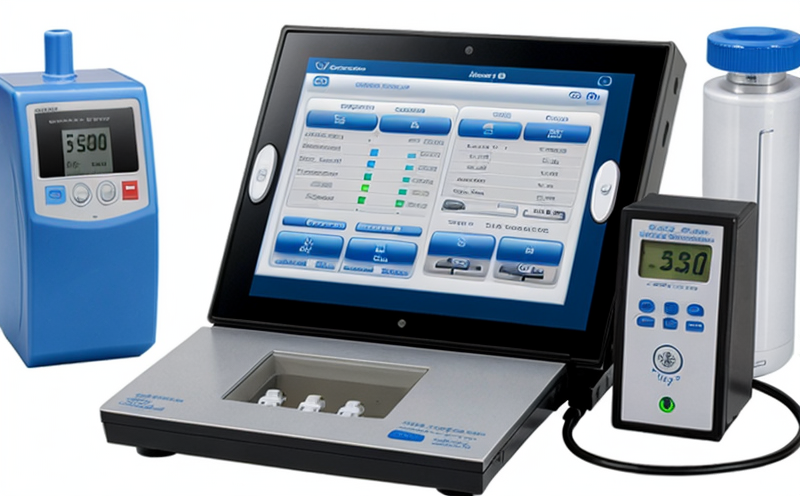ASTM F1929 Dye Penetration Seal Integrity Testing
The ASTM F1929 standard provides a method to evaluate seal integrity and dye penetration in infusion pumps and drug delivery systems. This testing is critical for ensuring the reliability of medical devices that deliver life-saving medications directly into patients’ veins.
During this test, a colored fluid (typically methylene blue) is introduced under pressure into the pump’s sealed components to simulate real-world conditions. The integrity of seals is then assessed by visually inspecting for any dye leakage beyond specified boundaries. This ensures that leaks are minimized or eliminated, thereby enhancing patient safety.
The primary objective of ASTM F1929 testing is to identify potential weaknesses in the design and manufacturing process of infusion pumps and drug delivery systems. By simulating stress conditions similar to those encountered during actual use, this test helps manufacturers ensure that their products meet strict quality standards before they reach healthcare facilities.
Manufacturers often conduct ASTM F1929 testing early in the development cycle when designing new models or modifying existing ones. This allows for iterative improvements based on feedback from rigorous evaluation processes. Additionally, regulatory bodies like the FDA may require compliance with certain standards such as ASTM F1929 before approving a product for market release.
Understanding how to properly prepare specimens is essential for accurate results. Specimens must be cleaned thoroughly prior to testing; any dirt or debris could interfere with dye penetration and potentially lead to false positives during analysis. Once prepared, the specimen should remain undisturbed until ready for testing.
The test setup typically involves placing the specimen in a fixture designed specifically for ASTM F1929 compliance. The fixture holds the specimen securely while applying pressure from multiple directions simultaneously. Pressure levels are carefully controlled to simulate realistic operating conditions without causing damage to the sample itself.
Once testing is complete, visual inspection plays a crucial role in determining whether there has been any dye leakage past designated boundaries within the sealed components of the pump or system. If no leaks are observed under scrutiny, it indicates successful sealing performance which aligns with industry best practices and regulatory requirements.
In summary, ASTM F1929 testing is vital for ensuring that infusion pumps and drug delivery systems maintain proper seal integrity throughout their lifecycle. By adhering to this standard, manufacturers can enhance product reliability while also addressing potential safety concerns associated with improper seals in medical devices.
Industry Applications
The application of ASTM F1929 seal integrity testing extends across various segments within the broader medical device industry. This includes not only infusion pumps but also programmable syringe drivers, patient-controlled analgesia devices, and other advanced drug delivery systems.
Manufacturers rely on this type of testing to meet regulatory requirements set forth by organizations such as the U.S. Food & Drug Administration (FDA), European Medicines Agency (EMA), and International Organization for Standardization (ISO). Compliance with these standards ensures that products are safe, effective, and reliable when used in clinical settings.
Additionally, ASTM F1929 testing supports continuous improvement efforts aimed at enhancing patient safety. By identifying defects early in the manufacturing process, companies can implement corrective actions to prevent issues from affecting end users. This proactive approach helps reduce recalls and improves overall quality assurance practices within the industry.
International Acceptance and Recognition
The ASTM F1929 standard enjoys widespread acceptance among regulatory authorities, healthcare professionals, and manufacturers globally. Its broad applicability underscores its importance in ensuring consistent quality across diverse markets.
In the United States, the FDA recognizes ASTM standards as voluntary guidelines that support compliance with federal regulations. For instance, under 21 CFR Part 820, which governs Quality Systems Regulations for medical devices, adherence to ASTM F1929 can serve as evidence of a manufacturer’s commitment to quality.
Similarly, European Union directives require conformity assessment bodies to consider relevant international standards like ASTM F1929 when evaluating products for CE marking. This certification process ensures that infusion pumps and drug delivery systems meet essential safety, health, and environmental requirements before being sold within the EU market.
Beyond North America and Europe, other regions such as Asia-Pacific and Latin America have also embraced ASTM F1929 due to its robustness in addressing seal integrity challenges. As global trade continues to expand, maintaining consistency with international standards like this one becomes increasingly important for seamless operations across borders.
Use Cases and Application Examples
| Use Case | Description |
|---|---|
| Infusion Pump Design Validation | Determine whether newly designed infusion pumps meet seal integrity requirements specified by ASTM F1929. |
| Manufacturing Quality Control | Evaluate the consistency of seal integrity across batches produced during manufacturing processes. |
| Device Modification Verification | Assess changes made to existing devices, ensuring they still comply with ASTM F1929 standards post-modification. |
| R&D Innovation Testing | Explore new materials or configurations for seals by validating their performance against ASTM F1929 criteria. |
| Post-Market Surveillance | Monitor in-use devices to detect any potential failures related to seal integrity that could impact patient safety. |
| Supplier Evaluation | Verify the reliability of components supplied by external manufacturers using ASTM F1929 as a benchmark for quality. |





